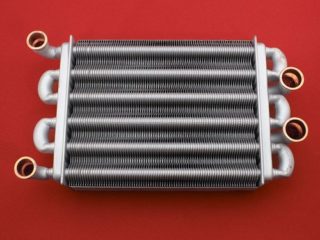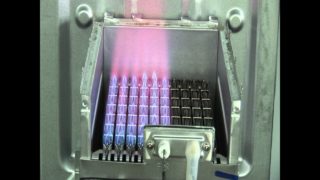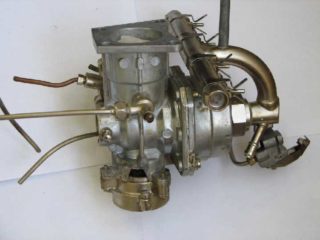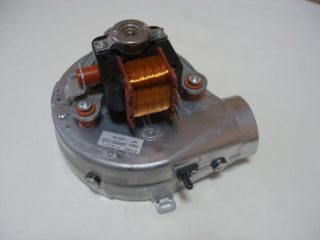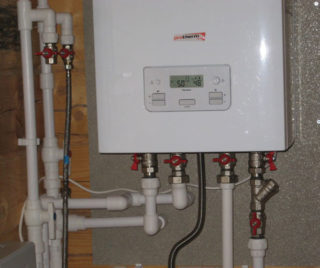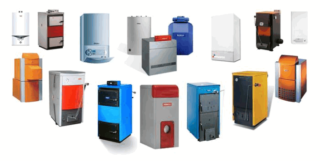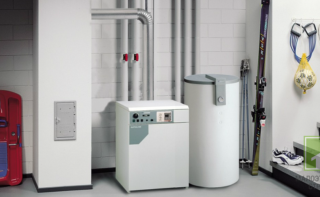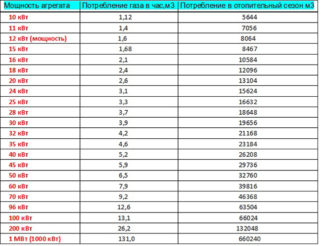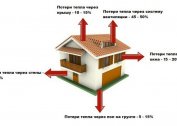The main element of the heating system of a private house is a boiler. The unit is needed to heat the coolant, which moves through pipes to the batteries. The popularity of devices is associated with the cheapness of energy, high efficiency and ease of operation. The user needs to know the device of the gas boiler in order to select the correct model and identify possible problems.
Gas boiler design
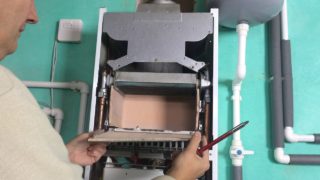
Before considering the principle of operation and varieties of heating units, you need to understand their device. Gas boiler consists of several nodes.
Primary heat exchanger
It is performed in the form of a metal box with a built-in radiator. Pipes are located inside this element. The heat exchanger is heated by gas and supplies heat to the water. Elements vary by type of material:
- Steel. Inexpensive and simple products that are heavy. Cons of heat exchangers - susceptibility to oxidation and significant fuel consumption.
- Cast iron. Models with a long service life, but only in conditions without temperature differences.
- Copper. It is not subject to corrosion, has a high efficiency. The disadvantage of the site is the risk of breakage due to mechanical stress.
The strength of the copper heat exchanger increases with a modulating burner.
Secondary heat exchanger
Included in the boiler device with two circuits, made of copper or structural steel. Secondary heat exchangers differ in the type of circuits:
- Lamellar. Metal products with extruded channels are single-pass (the direction of water does not change) and multi-pass (you can change the direction of water). They are connected by the method of assembly or soldering.
- Shell and tube. They are made like a pipe with small nozzles. The coolant moves along them, entering the heater or DHW.
- Bithermal. They look like two tubes inserted one into one. Domestic water is supplied to the domestic hot water supply, and external water is supplied for heating.
Shell-and-tube models are used for industrial boilers.
Gas-burner
Carries out heating of the heat carrier, happens pressurized and atmospheric. Supercharged modifications are characterized by high performance, atmospheric ones - by minimal noise level.
Pump
The circulation pump provides for the transfer of water through the heating main, its slow cooling. Using a pump reduces fuel costs. Before starting the heating unit, an air plug is pumped out of the pump.
Gas fittings
Reinforcing elements include several devices:
- Fuses - automatically remove water or steam from the system when the pressure is exceeded. For models with a pressure limit of up to 0.07 Pa, fuse fuses are used, more than 0.07 Pa - lever-cargo and spring valves.
- Water indicators - devices in the form of a glass case, tubes and taps monitor the water level.
- Shut-off and control valves - represented by valves (boilers with a passage diameter of 100-150 mm) and valves. Single-circuit heaters are equipped with check valves.
Two water indicators are placed on one boiler.
Three-way valve
Regulates the direction of the coolant in the presence of a DHW system. A T-piece with one outlet and two inlets is made of bronze. Inside the valve there is a membrane for adjusting the incoming coolant flows.Automatic three-way actuators are activated by water temperature, mechanical ones are manually set according to the thermometer.
Turbine
It is placed on models where there is a closed type of combustion chamber and rotary chimney. The unit is made in the form of a fan that supplies air. The streams support the combustion process and remove combustion products.
Varieties of gas boilers
The classification of a gas boiler is carried out according to several criteria.
Number of circuits
A single-circuit device provides only room heating, without hot water supply. The double-circuit unit is connected to the DHW communications and heats the house.
Way to create traction
The draft of gas-fired boilers is:
- natural - realized when the difference in specific gravity of air in the room and outside;
- forced - the fan pumps traction.
Natural draft models require a high-quality chimney.
Ignition Method
The operation of the boiler starts after activation:
- electronic ignition system - automatically, without user intervention;
- piezoelectric element - the device ignites after a person presses a special button.
Electronic ignition requires electricity.
Mounting method
Depending on the installation method, you can choose the unit:
- Wall - is fixed on the wall surface with anchor bolts, is compact. The model is suitable for small rooms. The downside is the sensitivity of heat exchangers to the chemical composition of water.
- Floor-mounted in a separate room. The boiler room is equipped in accordance with state regulations. Modification with high efficiency, able to heat a large area.
Floor-standing boilers always have two circuits, wall-mounted boilers can have one.
The principle of heat storage
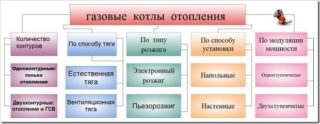 Boiler units are similar in appearance, but differ in engineering solutions:
Boiler units are similar in appearance, but differ in engineering solutions:
- A convection device burns gas by heating water with a single heat exchanger. During the circulation of the coolant in the chimney, condensate settles into the heat exchanger. The acid composition of the liquid leads to breakdown of the element.
- The condensing unit is equipped with a secondary heat exchanger, on which condensate settles. The residual heat of the precipitate is accumulated by the heating element.
Efficiency of convection models - 88-92%, condensation - 103-115%.
Power type
There are several modifications of boilers:
- Single stage. Adjustment of temperature parameters is carried out through switching on and off.
- Two-stage. Combustion can be set in two modes - 40% or 100%.
- Modulated. The power range of the elements varies from 10 to 100%.
Modulated devices provide smooth adjustment of flame height and water temperature, but are not cheap.
Operating principle
For central and autonomous heating mains, natural gas with methane and propane-butane combustion is used. Regardless of the burning mixture, the principle of operation of the boiler is presented:
- By connecting. In the presence of gas manually or automatically, the device ignites.
- Sincerely. The burner ignites when a spark is generated from electricity.
- Activation of the main burner. The process is carried out using an igniter.
- Heated coolant and water jacket. A heat exchanger is used to perform this operation. The element heats the water to the set temperature parameters, then the burner turns off.
When the temperature drops, when the boiler is running, the touch sensor transmits signals to the automation. The system starts functioning until the coolant is warmed up again.
Advantages and disadvantages
The positive aspects of equipment operation include:
- the low cost of gas fuel in comparison with electricity, wood, fuel oil or coal;
- high efficiency;
- connection to hot water supply and heating of models with two circuits;
- selection of installation for large and small houses;
- simplicity of independent operation;
- compatibility with other devices - a boiler or communications for hot water is connected to the unit;
- the possibility of mounting wall modifications in the apartment, floor - in a private house.
The disadvantages of gas-fired boiler equipment are installation costs - connection is made by permission of Gaztekhnadzor. The economical operation of the device is achieved only with a gas line.
Selection rules
When selecting a gas type boiler, consider several criteria:
- Convection models are cheaper than condensation ones, but they have lower efficiency and heat exchangers break more often.
- Boilers with an open combustion chamber are not suitable for apartments. They are placed in a separate room with a high-quality ventilation system. It is better to stay on equipment with a closed camera.
- Power of wall units - up to 32 kW, floor - from 100 kW.
- Wall-mounted boiler provides high-quality heating of buildings up to 300 m2. If the house is more than 300 m2 - the floor option is suitable.
- To reduce heat costs, it is better to choose two-stage or modulated devices.
- Devices with natural circulation are not suitable for rooms larger than 100 m2.
- Floor modifications up to 60 kW can be connected in the kitchen.
- Wall-mounted units are low-noise - they can be placed in the kitchen or in the hall.
- A sample with an atmospheric burner requires a separate chimney from 4 m high.
- A pressurized burner (power from 100 kW) must be connected and installed separately.
When choosing power parameters, consider that 1 kW of heat heats 10 m2 of the home.
The operation of gas boilers is an economical way to heat a house. Owners do not need to solve the issue of transportation and storage of solid fuel, pay extra for electricity. With knowledge of the varieties and the principle of operation of the units, it is easy to choose an option for a particular room.
